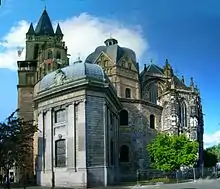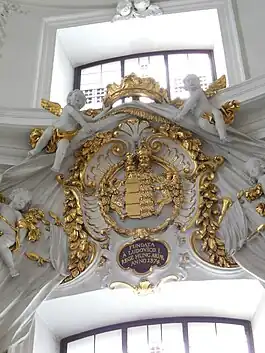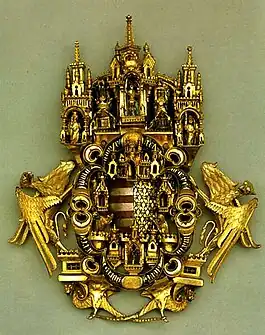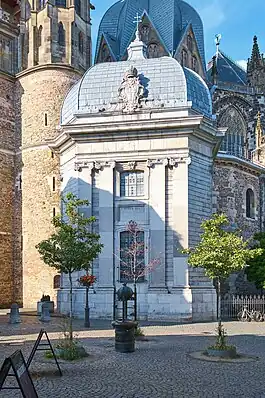Aachen Chapel of Hungary
Aachen Chapel of Hungary (Hungarian: Aacheni magyar kápolna) is a side chapel of the Aachen Cathedral (German: Aachener Dom), one of the oldest cathedrals in Europe.
| Aachen Chapel of Hungary | |
|---|---|
 | |
| Religion | |
| Affiliation | Roman Catholic |
| Province | Diocese of Aachen |
| Location | |
| Location | Aachen, North Rhine-Westphalia, Germany |
| Geographic coordinates | 50°46′29.1″N 6°5′2.12″E |
| Architecture | |
| Type | chapel |
| Criteria | Cultural: i, ii, iv, vi |
| Reference | 3 |
| Inscription | 1367 (Unknown Session) |


Aachenfahrt
The Aachen Cathedral and the relics it contains have been related to Hungary for more than a millennium. The textiles associated with the Incarnation of Jesus have attracted hundreds of thousands of pilgrims, including Hungarians, since the reign of Charlemagne.[1]
The founding of the Aachen Chapel of Hungary is linked to the pilgrimages known as the Aachenfahrt,[2] in which Hungarian pilgrims had been participating in large numbers since the time of Stephen I of Hungary. Aachen was the third most important pilgrimage site in medieval Europe, next to Rome and Santiago de Compostela.[3] In Germany, the custom of the Aachenfahrt is linked to the veneration of the relics of the Holy Land donated to the Aachen Cathedral by the Frankish Emperor Charlemagne. In Hungary, this tradition, of which we only have certain records from the beginning of the 14th century, was probably introduced by settlers from the Walloon and Rhineland regions. The Aachen Rites soon became attractive to Hungarian believers through the Germans who settled in Hungary.[4]

Hungarian pilgrims
According to contemporary chronicles, despite the distance of over a thousand and two hundred kilometres, Hungarians were always the most numerous of all nations to participate in the Aachen farewell processions, with some years seeing over five thousand Hungarian pilgrims.[5]
The procession of pilgrim groups of hundreds of people - some of them by water, the Danube and the Rhine - lasted several weeks, usually more than a month. They followed the route Vienna - Passau - Regensburg - Nuremberg - Frankfurt - Mainz - Koblenz. On their way to Aachen, the Hungarian pilgrims could also stop in Cologne, where there was a lodging house reserved just for them.[6] Wealthy Hungarians also built beautiful houses around the cathedral, most of which still decorate the old town. In 1804 they were evicted by Emperor Napoleon Bonaparte, whose favorite residence was Aachen.[7]
Construction of the Chapel of Hungary
Louis I of Hungary's mother Elizabeth of Poland, Queen of Hungary, visited the tomb of Elizabeth of Hungary in Marburg and the Shrine of the Three Kings in Cologne during her pilgrimage in 1357. Finally, with her large entourage, she made a pilgrimage to Aachen, where she met Charles IV, Holy Roman Emperor and his wife Anna von Schweidnitz. During her visit, the Dowager Queen made a rich gift to the shrine in Aachen (some of these Hungarian treasures can still be seen in the treasury of the cathedral).[2][8]
The lessons and experiences of his mother's pilgrimage encouraged Louis I of Hungary to build a chapel in Aachen to match the cathedral.[4][9] During the pilgrimage of 1364, he made a large donation to build it and to keep two Hungarian priests. The chapel was completed in 1367 in Gothic style. The foundation charter also included ecclesiastical furnishings, vestments, chalices, altarpieces, candlesticks and missal books, which were also provided by the Hungarian king. He also provided for the income of the chapel by purchasing land in the vicinity of Aachen, the proceeds of which were to be used to maintain the Chapel of Hungary and for the needs of the Hungarian chaplains. The legal relations between the Hungarian dynasty and the City of Aachen were regulated by a donation charter in 1370.[10]
The Gothic chapel built on the south side of the cathedral was directly connected to the Carolingian octagon, the octagonal church of Charlemagne. The chapel had altars with the relics of Stephen I of Hungary, Saint Emeric of Hungary and Ladislaus I of Hungary, which must have been built by 1366, because Pope Urban V had already granted privileges to the chaplain of the chapel dedicated to Ladislaus I of Hungary in a bull of his.[11] In 1374, it is assumed that Louis I of Hungary himself visited Aachen to see the chapel, where the relics of the Hungarian saints gave the shrine a slightly Hungarian touch. This also contributed to the fact that the building was soon referred to as the Chapel of Hungary by the locals.[12]
Reconstruction of the Chapel of Hungary
In the early 16th century, with the spread of the Reformation, the structural condition of the chapel deteriorated as donations from Hungarian pilgrimages temporarily dwindled.In 1656, a great fire in Aachen destroyed the roof of the Chapel of Hungary. The treasures kept there were moved to the city hall to protect them from destruction. Afterwards, the chapel was even more neglected and fell into a state of ruin and disrepair.
During the reign of Maria Theresa, the Hungarian lords involved in the War of succession often visited Aachen, where the imperial armies were headquartered. In 1747, General Károly Batthyány, in agreement with the other Hungarian generals, commissioned the municipal architect Johann Couven to renovate the chapel. The Gothic chapel was completely demolished and the foundation stone of the new chapel was laid. However, construction was slow and did not go according to the original plans, and over time the newly built walls sank and collapsed. As a result, the entire building had to be demolished.
The work was then entrusted to the Milanese architect Joseph Moretti in 1756. By 1764, the chapel's roof was finished. The chapel, rebuilt in the Baroque-Classicist style, has a rounded square exterior and a circular interior, with one side facing the cathedral and the other half facing the south staircase. The three windows and the entrance are each surmounted by a large coat of arms with a stylised crown above, with shutters on either side closed by a wide drapery. Underneath, on a black panel, is the inscription 'FUNDATA A LUDOVICO I REGE HUNGARIAE ANNO 1374' (FUNDED BY KING LAJOS I OF HUNGARY IN 1374).
On the arch above the entrance, next to the coat of arms of Maria Theresa, on the right is that of Francis II, Holy Roman Emperor and on the left that of Joseph II, Holy Roman Emperor. In the niches of the chapel are statues of the four Hungarian saints. Stephen I of Hungary is leaning on a cross with his right hand, wearing the Hungarian crown on his head, his body covered with armour and a cloak. Ladislaus I of Hungary is also wearing a crown, holding a rudder staff in his right hand and leaning on an oval shield with his left. Saint Emeric of Hungary is also holding a baton and a lily in his hand, with his left hand on his heart. The fourth statue is of Adalbert of Prague, in episcopal regalia, leaning on his shepherd's crook with his left hand and holding a book in his right. On the inner wall on the right, a black marble plaque lists in Latin the holy kings and princesses of Hungary.
Hungarian treasures and the Chapel of Hungary today
According to inventories recorded in 1367 and 1381, Louis I of Hungary donated two tablets to the Chapel of Hungary and a third to the cathedral. They are now kept in the treasury of the cathedral, where, among other things, the silver coffin of Charlemagne, his golden enamel bust and his hunting horn can be seen. The Madonna and Child and the Coronation of Mary are therefore only 14th-century copies of the magnificent pentagonal frames, while the paintings in the frames themselves are 18th-century copies, and are on display on the first floor of the cathedral's treasury.[13]
Nowadays, the Chapel of Hungary is located to the right of the main entrance as you enter the main cathedral. The chapel, which, like the cathedral, is in excellent condition, is now an intimate space for quiet prayer in the church.[14]
Bibliography
- Tömöry Edith: Az aacheni magyar kápolna története. Németh József Technikai Könyvkiadó Vállalat, Budapest, 1931.
- Pór Antal: Keszei Miklós 13??-1366 Budapest A Magyar Történelmi Társulat kiadása. 1904
- Udvarhelyi Nándor: Aachen magyar kincsei
- Marianne Jungen: Die Geschichte der Kaiserstadt Aachen von den Römern bis zur Neuzeit und vieles mehr. 1. Auflage. AC-Verlag Jungen, 1995.
- Michael Römling: Aachen. Geschichte einer Stadt. Soest 2007.
Other information
References
- "Magyar zarándokok is részt vesznek a nagy múltú aacheni búcsúban". Magyar Kurír (in Hungarian). Retrieved 2023-10-10.
- "ZARÁNDOKLAT - VIA SACRA - AACHENI BÚCSÚ 2023 - Zarándoklat Németországba". Via Sacra (in Hungarian). Retrieved 2023-10-10.
- AZ AACHENI ZARÁNDOKLATRÓL Szent Adalbert templom 2023. június 17. https://ungarnzentrum.de/media/zar_ndokfuezet-aachen-2023.pdf
- "Tömöry Edith. Az aacheni magyar kápolna története - PDF Ingyenes letöltés". docplayer.hu. Retrieved 2023-10-10.
- Gutenberg Nagy Lexikon, 1. kötet. A - Aiolok (Budapest, 1931) | Arcanum Digitális Tudománytár - adt.arcanum.com.
- Pásztor Lajos: A magyarság vallásos élete a Jagellók korában. Bp., 1940. 126, 128.
- Jean Charles François Baron de Ladoucette: . Hrsg.: Birgit Gerlach. 1. Auflage. Antiquariat Am St. Vith, Mönchengladbach 2009, ISBN 978-3-00-028810-4.
- PÓR ANTAL - KESZEI MIKLÓS - 13??-1366 A MAGYAR TUD. AKADÉMIA SEGÉLYEZÉSÉVEL KIADJA A MAGYAR TÖRTÉNELMI TÁRSULAT, SZERKESZTI DR. DÉZSI LAJOS --- A MAGYAR TÖRTÉNELMI TÁRSULAT KIADÁSA, BUDAPEST - 1904 https://mek.oszk.hu/05600/05622/html/
- "A magyar zarándokokat is várják az aacheni búcsúra – Az eseménynek Erdő Péter is résztvevője lesz". Magyar Kurír (in Hungarian). Retrieved 2023-10-10.
- Zur Ungarn-Kapelle siehe Hans-Karl Siebigs: Die Ungarnkapelle am Dom zu Aachen. In: ders., Bauliche Sanierungsmaßnahmen an der Ungarnkapelle des Domes zu Aachen in den Jahren 1991–1994 (= Schriftenreihe des Karlsverein-Dombauvereins. Band 3). Aachen 2000
- Tömöry Edith:Az Aacheni magyar kápolna története. Bp., 1931. 5–6. https://docplayer.hu/23817451-Tomory-edith-az-aacheni-magyar-kapolna-tortenete.html
- Pásztor Lajos: A magyarság vallásos élete a Jagellók korában. Bp., 1940. 125–126.
- Dercsényi Dezső: Nagy Lajos kora. Bp., 1941. (reprint: 1990) 150.
- Christph Stender, Heike Nelsen-Minkenberg Aachen Cathedral einhard verlag gmbh, Aachen 2012 ISBN 978-3-936342-74-1 p.40